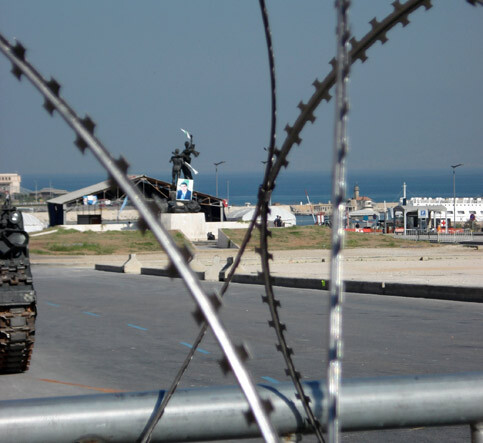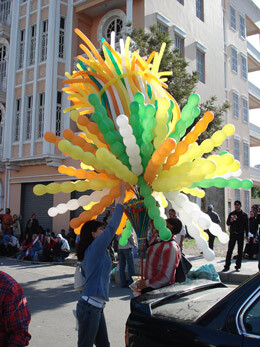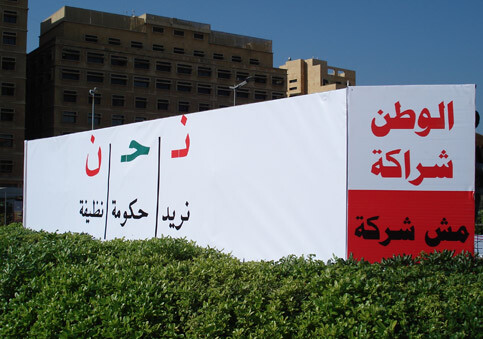Beirut 4 December 2006

Martyr’s Square fenced off to opposition protesters (Marcy Newman)
Beginning Thursday evening the streets of Beirut were filled with anticipation. As with the night before the March 14th Coalition’s rally in Martyr’s Square after Pierre Gemayel’s assassination, cars full of Lebanese people flying various flags (national and party) outside of their windows cruised through the streets of Beirut honking and blasting music. The feel, at least from where I listened to this from my apartment, was of a small American town after the big Friday night football game. The following morning was one of intense traffic, bottlenecked because people were trying to get home or to work and so many of the streets in downtown Beirut were closed off and military installations were all over the city, including in my neighborhood, Hamra.
The following morning, after my Arabic class (one was canceled), I walked downtown to attend the rally that was the source of all the excitement the night before. The walk downtown is about 30-40 minutes and there’s no street in Beirut that isn’t beautiful to walk down. Although the rally wasn’t scheduled to begin until 3 PM, I wanted to arrive early to see things coming together. The closer I walked towards downtown the more empty things were. The main Riad El-Solh shopping/cafe district was a ghost town. All of the streets were blocked off, eventually even to pedestrians, and mostly the people who were there were soldiers on the street, in Jeeps, or in tanks. The lead-up to this rally has been quite intense with the rhetoric of the government suggesting or alluding to the possibility of violence at the rally when all that Amal, Aoun, or Hezbollah ever seemed to call for as far as I can see was for a new government that is more representative of the people and free from corruption. In general, the press has been foreshadowing (or predicting a self-fulfilling prophecy?) that increased tensions would lead to a renewal of conflict as with the Lebanese Civil War. It’s amazing that such language comes as a response to a call for civil disobedience. And yet the language in the Daily Star of late and elsewhere has been just that. It’s almost as if two school children are on the playground daring each one to strike first and with each insult tension becomes escalated. Of course such rhetoric gets tossed about heavily in the U.S., making people worry in anticipation of some catastrophe.

Balloons matching political parties’ colors for sale at the rally (Marcy Newman)

Nahnu political slogan and podium (Marcy Newman)
I wandered over to the main area which centered in the parking lot across from the Buddha Bar a few blocks away. All around as I marched with other people I noticed snipers on the tops of each tall building around downtown. There were also new posters and campaigns on podiums, flags, and placards that people carried. The three Arabic letters spelling nahnu, or “we,” were separated, when normally they should be connected (in Arabic script most of the characters must be connected to each other). I think they did this because the word itself was also, in this case, used as an acronym for the political platform yesterday. Each letter stood for words that taken together means “we want a clean government.” In typical Hezbollah fashion the publicity/public relations was very savvy, nicely designed, and powerful. What was strange were the speeches given that suggested that somehow the Sinora government is a U.S. backed government. Maybe in the post-July war Bush and Company are backing Sinora, but anyone who thinks that this is consistent has a very short memory. Doesn’t anyone remember the rhetoric coming from the White House and Condoleezza Rice this summer when they stood by the Zionist state of Israel? When they claimed that this war was somehow the “birth pangs of a new Middle East” in which case they envisioned a new democratic state in Lebanon? All of that rhetoric certainly was not supportive of anyone or anything in Lebanon and certainly sounded to me like the U.S. was far more interested in installing a new U.S. government of its own persuasion. This has always been true with U.S.-Lebanese relations: when it’s convenient for the U.S. to support Lebanon they do (if only be rhetorical maneuvers, never in any tangible way) and when it’s convenient for the U.S. to antagonize or take away its support it does so. Tensions had also been high because of a couple of events, seemingly isolated incidents, that occurred the previous week after Gemayel’s funeral. The first one erupted after some one/people took down Michel Aoun’s large “Aoun for President” poster in the middle of Sassine Square in Ashrafiyeh (a suburb of Beirut). When people from Aoun’s party returned to put it back up, there were clashes between the Lebanese Forces and the Free Patriotic Movement on Tuesday. The second one involved a man connected to a Syrian militia who blew himself up at the Lebanese-Syrian border also last Tuesday.

Protesters line the lawn and the highway (Marcy Newman)
In any case, the rally became increasingly crowded, and the downtown streets seemed to become increasingly forbidden to walk on; we were sort of caged in by the army into particular areas: parking lots, parks, etc. We were not allowed to go anywhere near Martyr’s Square proper as it was all fenced off with barbed wire. As the crowds rolled in people began amassing on the highway above, which was closed to traffic at this point (eventually tents were set up there too for overnight camping). It felt a bit like New York City demonstrations where the police cage you into a particular march route and you can’t leave. I’m not sure what the final count was, but the Daily Star reported that there were hundreds of thousands of people there. I wound up finding a path through the Khalil Gibran garden that led up to a highway taken over by the people. I walked through a tunnel back to Hamra to find deserted streets there, too (at least in terms of cars). Before I left the rally a woman from Noor Radio interviewed me about why I was there. She wanted to know if I supported the political platform there. I told her that what I supported was a government that truly represents the people of Lebanon as well as other people who live here, namely Palestinians living in refugee camps who are banned from something like seventy professions, who cannot get a decent education or health care, and who cannot inherit material goods from their families. This is something I’d love to see Lebanese politicians make a priority in their platforms. One of the things I’m most interested in right n ow is finding a way for Israelis to be tried for war crimes, perhaps in a way similar to the case targeting Donald Rumsfeld right now. The problem is that some people I’ve discussed this with, who know people at the ICJ or the ICC have stated that Hezbollah is afraid that if Israeli is pursued that they will be to. This is not necessarily the case. Julie Flint, a reporter for The Guardian in London makes the case, however, of how one might proceed with such a trial in ways that would castigate Israel on the world stage. This seems to me to be a much loftier goal than focusing only on a trial for the murder of Rafiq Hariri. While that may be important, too, it seems to me that the world would, including Lebanon, would benefit from pursuing a war crimes trial directed at Israel whereas perhaps only Lebanon might benefit (and then even only some in Lebanon) from a trial focusing on such an insular issue.
Dr. Marcy Newman is Visiting Professor at the Center for American Studies and Research at the American University of Beirut. She works with Civilian Resistance in Lebanon. You can follow her activities at her blog.
Related Links





